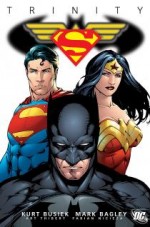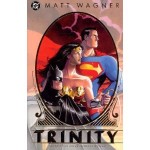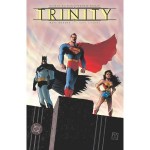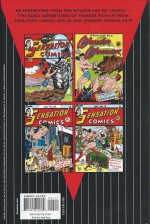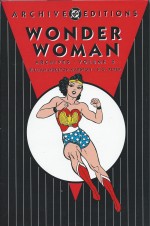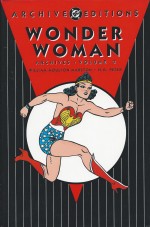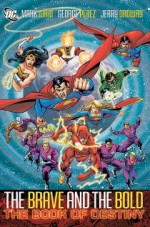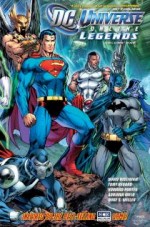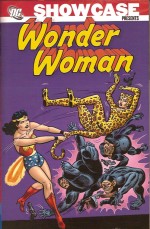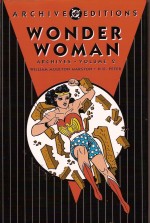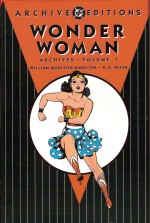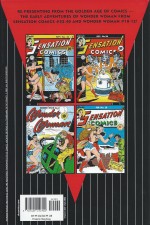
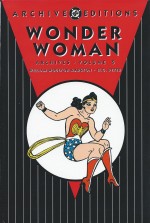
By Charles Moulton (William Moulton Marston & Harry G. Peter) with Joye Murchison (DC Comics)
ISBN: 978-1-4012-1270-4
The Princess of Paradise Island debuted as a special feature in All Star Comics #8 (December 1941), conceived by polygraph pioneer William Moulton Marston and illustrated by Harry G. Peter, in a calculated attempt to offer girls a positive and forceful role model and, on Editor M.C. Gaines’ part, sell funnybooks.
She then catapulted into her own series, and held the cover-spot of new anthology title Sensation Comics a month later. An instant hit, the Amazing Amazon won her own eponymous supplemental title a few months later, cover-dated Summer 1942.
Once upon a time on a hidden island of immortal super-women, American aviator Steve Trevor of US Army Intelligence crashed to Earth. Near death, he was nursed back to health by young, impressionable Princess Diana.
Fearful of her besotted child’s growing obsession with the creature from a long-forgotten and madly violent world, Diana’s mother Queen Hippolyte revealed the hidden history of the Amazons: how they were seduced and betrayed by men but rescued by the goddess Aphrodite on condition that they forever isolated themselves from the mortal world and devoted their eternal lives to becoming ideal, perfect creatures.
However with the planet in crisis, goddesses Athena and Aphrodite now instructed Hippolyte to send an Amazon back with the American to fight for global freedom and liberty, and Diana clandestinely overcame all other candidates to become their emissary Wonder Woman.
On arriving in America she bought the identity and credentials of lovelorn Army nurse Diana Prince, elegantly allowing the Amazon to be close to Steve whilst enabling the heartsick medic to join her own fiancé in South America. Diana gained a position with Army Intelligence as secretary to General Darnell, ensuring she would always be able to watch over her beloved. She little suspected that, although the painfully shallow Steve only had eyes for the dazzling Amazon superwoman, the General had fallen for the mousy but supremely competent Lieutenant Prince…
Using the nom de plume Charles Moulton, Marston (with some help in later years from assistant Joye Murchison) scripted the Amazing Amazon’s fabulous adventures until his death in 1947, whereupon Robert Kanigher took over the writer’s role. Venerable veteran illustrator and co-creator H.G. Peter performed the same feat, limning practically every titanic tale until his own death in 1958.
This fifth lavishly deluxe full-colour hardback edition collects the increasingly fanciful and intoxicating adventures from Wonder Woman #10-12 and Sensation Comics #33-40, spanning cover-dates September 1944-April 1945 and following the unique champion of freedom from her primarily war-footing to the scary days of a world notionally at peace…
After an appreciative Foreword from industry insider, historian and comics all-star Jim Amash detailing the cultural contribution of the creators and their billion-dollar baby, the action opens with ‘The Disappearance of Tama’ from Sensation Comics #33, wherein the Amazon’s college friend Etta Candy overhears a plot to kidnap and murder a movie starlet and embroils herself and Diana in a delightfully bewildering farrago of deadly doubles and impish impostors, after which Wonder Woman #10 (Fall 1944) offered a novel-length epic of alien invasion.
In ‘Spies From Saturn’, a rare vacation with Etta and her sorority sister Holliday Girls leads to trouble with outrageous neighbour Mephisto Saturno who turns out to be the leader of a spy ring from the Ringed Planet. However even after imprisoning his extraterrestrial espionage squad the danger is not ended, as the aliens insidious “lassitude gas†turns America into a helpless sleeping nation and forces the Amazon to take ‘The Sky Road’ to the invaders’ home world to find a cure and rescue her beloved Steve…
The cataclysmic clash concludes in ‘Wonder Woman’s Boots’ as the victorious Earthlings return home, unaware that Mephisto is still free and has a plan to avenge his defeat…
Social injustice informed ‘Edgar’s New World’ in Sensation Comics #34, when the Amazing Amazon tackled the case of a “problem child†near-blind and living in squalor whilst his mother languished in jail. Soon however the big-hearted heroine uncovered political chicanery and grotesque graft behind the murder charge sending innocent Esta Poore to the death chamber…
In Sensation #35 ‘Girls Under the Sea’ found Wonder Woman again battling to save lost Atlantis from tyranny and misrule after beneficent ruler Octavia was ousted by a committee of seditious anarchists, whilst #36 pitted the Power Princess against deranged actor Bedwin Footh, a jealous loon who envied the Amazon’s headline grabbing, and organised her old foes Blakfu the Mole Man, Duke of Deception, Queen Clea, Dr. Psycho, The Cheetah and Giganta into an army against her. However all was not as it seemed in the ‘Battle Against Revenge’…
Wonder Woman #11 (Winter 1944) offered big thrills and rare (for the times) plot continuity as ‘The Slaves of the Evil Eye’ saw Steve and Diana battling an uncanny mesmerist intent on stealing America’s defence plans against Saturn.
The spy trail led to bizarre performer Hypnota the Great and his decidedly off-kilter assistant Serva, but there were layers of deceit behind ‘The Unseen Menace’, and a hidden mastermind intent on re-igniting the recently-ended war with Saturn in the climactic final chapter ‘The Slave Smugglers’.
This spectacular psycho-drama of multiple personalities and gender disassociation was another masterpiece directly informed by Marston’s psychiatric background and provided another weirdly eccentric tale unique to the genre…
With the war in Europe all but over, comicbook content was changing and constantly experimenting. Sensation Comics #37 (January 1945) depicted ‘The Invasion of Paradise Island’ wherein troubled orphans Kitty and Terry stow away aboard Wonder Woman’s invisible plane even as Diana and Steve were busting the orphanage’s crooked, grafting owner. When the kids were discovered back on Paradise Island they found themselves at the tender mercies of a horde of rambunctious Amazon toddlers (don’t ask – it’s comics, ok?) just as a U-Boat of escaping Nazis arrived looking for a safe harbour and refuge to conquer…
For years Wonder Woman had been celebrating Christmas with exceptional Seasonal offerings and #38 was no exception. ‘Racketeers Kidnap Miss Santa Claus’ revealed how young sceptic Pete Allen sought the Amazon’s help to save his mother from an abusive relationship and learned the true spirit of giving after the Amazon stopped a brutal bullion grab…
Etta and the Holliday Girls then resurfaced in #39 as an expedition to find a lost Roman colony left them ‘In the Clutches of Nero’ and urgently requiring the assistance of their Amazon associate to quash the ambitions of the latest madman to bear the name, whilst Sensation Comics #40 introduced urbane, untrustworthy freelance spy Countess Draska Nishki, eager to earn cold hard cash spying for General Darnell. Sadly her loyalties couldn’t stay bought and Steve and Diana had good reason to call her ‘Draska the Deadly’…
This glorious tome of treasures concludes with Wonder Woman #12 and another epic fantasy.
When alien Queen Desira declared WWII over, she also brought warning that warmongers were already preparing for the next conflict. In ‘The Winged Maidens of Venus’ this news inadvertently led to Diana Prince’s capture by spy Nerva and her bosses – a cabal of Capitalists who always profited from destruction – until Steve and Etta came to her rescue…
When the profiteers were transported to Venus for reconditioning, they escaped and fomented chaos and rebellion in ‘The Ordeal of Fire’ almost resulting in ‘The Conquest of Venus’ and carnage on Earth until Wonder Woman and Steve stepped in to save the day…
This last tale is credited to Marston’s assistant Joye Murchison who shared the author’s workload as first polio and then lung cancer increasingly hampered him until his death in 1947.
Seen through modern eyes, there’s a lot that might be disturbing in these old comics classics, such as plentiful examples of apparent bondage, or racial stereotypes from bull-headed Germans to caricatured African-Americans, but there’s also a vast amount of truly groundbreaking comics innovation too. The skilfully concocted dramas and incredibly imaginative story-elements are drawn from hugely disparate and often wondrously sophisticated sources, but the creators never forgot that they were in the business of entertaining as well as edifying the young.
Always stuffed with huge amounts of action, suspense, contemporary reflection and loads of laughs, as well as the scandalous message that girls are as good as boys and can even be better if they want, Wonder Woman influenced the entire nascent superhero genre as much as Superman or Batman and we’re all the richer for it.
This exemplary book of delights is a triumph of exotic, baroque, beguiling and uniquely exciting adventure: Golden Age exploits of the World’s Most Marvellous Warrior Maiden which are timeless, pivotal classics in the development of our medium and still offer astounding amounts of fun and thrills for anyone interested in a grand old time.
© 1944, 1945, 2007 DC Comics, Inc. All Rights Reserved.

